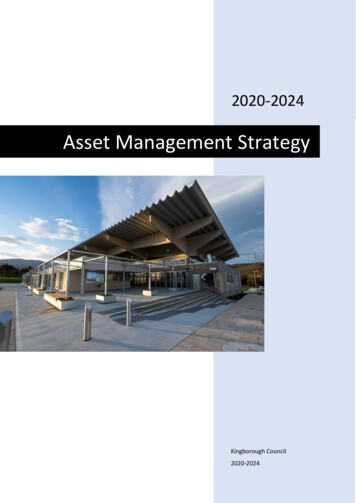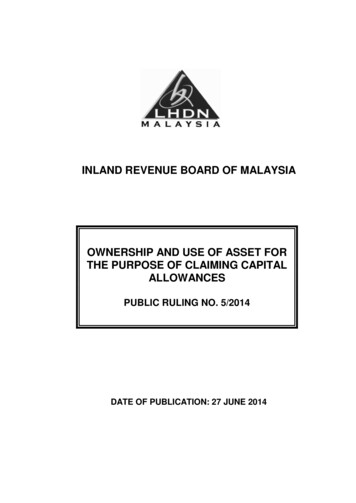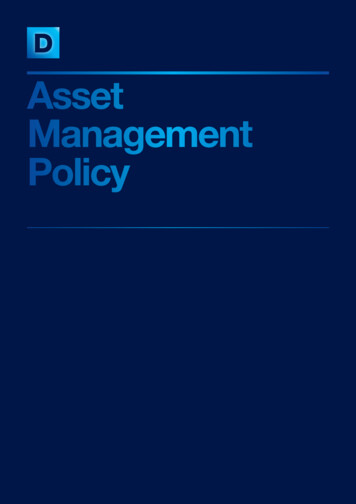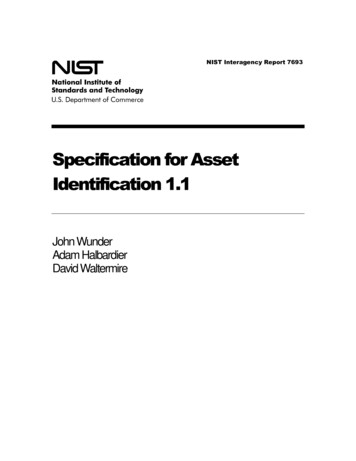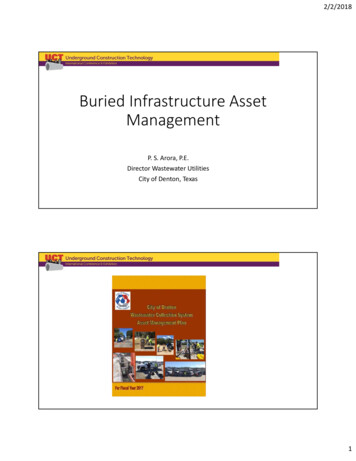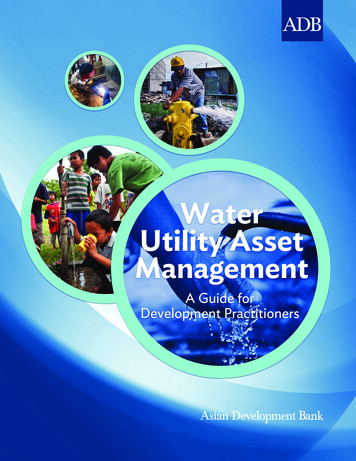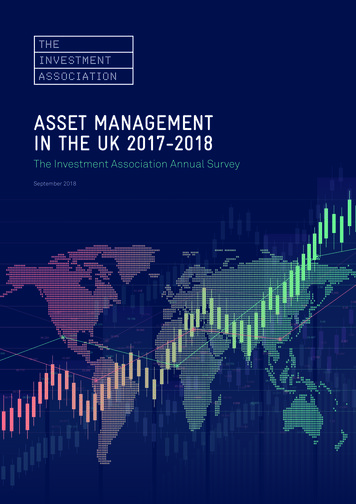
Transcription
ASSET MANAGEMENTIN THE UK 2017-2018The Investment Association Annual SurveySeptember 2018
CONTENT ENQUIRIESRuth Meade, 44 (0)20 7831 0898CONTRIBUTORSRuth MeadeAnastasia PetrakiAlastair WainwrightJonathan LipkinThe Investment Association (IA)Camomile Court, 23 Camomile Street, London, EC3A ber 2018 The IA (2018). All rights reserved.No reproduction without permission of the IA.2
ASSET MANAGEMENT SURVEY 2017-18 CONTENTSCONTENTSIndex of Charts, Figures and Tables5About the Survey8Survey Foreword10Executive Summary121. UK ASSET MANAGEMENT INDUSTRY: A GLOBAL CENTRE14Role of asset management15Size of the UK industry16Scale of wider industry17Scotland as a major centre17Position of UK asset management industry in Europe and worldwide18Overseas client market19Importance to UK service exports19Services to overseas funds20Safeguarding the global position of the industry20Supporting the UK economyInvestment in UK infrastructure2. CHANGING DYNAMICS OF ASSET MANAGEMENT IN THE UK:TOWARDS A NEW MAINSTREAM?Evolution in the investment ecosystem21222526Public vs private markets27Role of asset managers in funding SMEs29Increasing emphasis on responsible and sustainable investment29Ongoing change in product demand33Rapid technological change34Diverse patterns of corporate M&A activity35Significant regulatory and policy scrutiny38EU-level change: Impact of MiFID II39UK context42Stewardship and corporate governance43Broader economic contribution433. TRENDS IN CLIENT ASSETS AND ALLOCATIONClient typesLonger-term evolution of client base444546Segregated vs pooled investment47Asset allocation47Detailed asset allocation48Equity by region48Fixed income by region48Balance between active and passive503
THE INVESTMENT ASSOCIATION4. UK INSTITUTIONAL CLIENT MARKETClient breakdownPension schemesThe shape of the UK pension marketTrends in the third party institutional market5455565658Mandate breakdown59Investment trends within specialist mandates60Geographic allocation62Active vs passive64Segregated vs pooled645. RETAIL FUND MARKET66Funds under management67Funds under management by asset class67Drivers of growth68Retail fund sales69Retail sales in overseas funds69Explaining flows69Holding periods of UK funds71Investor objectives71Outcome and allocation in the ascendancy72A structural shift74Stronger equity growth sales, but outside the UK75Passively managed fundsTrends in fund distribution7678Distribution of passive funds79Wrappers used by retail investors in the UK79Fund of funds80Industry structure and concentration81UK Market in European context826. OPERATIONAL AND STRUCTURAL ISSUESRevenue and costs85Employment in the asset management industry86Direct employment87484Distribution of staff by activity87Industry concentration89Asset manager ownership92Boutiques92
ASSET MANAGEMENT SURVEY 2017-18 INDEX OF CHARTS, FIGURES AND TABLESINDEX OF CHARTS,FIGURES AND TABLESCHARTSChart 1: Total assets under management in the UK (2002-2017)17Chart 2: UK-managed assets by UK regional headquarters (June 2008-2017)17Chart 3: Export earnings of fund managers and contribution to services exports (1997-2016)19Chart 4: Change in proportion of assets managed for UK and Overseas (2015-2017)20Chart 5: New housing association financing by banks and capital markets24Chart 6: Number of listed domestic companies in traditional markets26Chart 7: Equity raised via U.S. IPOs vs. equity raised via private offerings27Chart 8: Net retail sales of ethical funds as a percentage of funds under management (2008-2017)29Chart 9: Proportion of SRI relative to total managed assets in 201630Chart 10: Dedicated investment according to specific ESG criteria31Chart 11: Assets managed in the UK by client type45Chart 12: Assets managed in the UK by client type (2008-2017)46Chart 13: Segregated versus pooled investment (2009-2017)47Chart 14: Overall asset allocation of UK-managed assets (2008-2017)47Chart 15: UK managed equities by region (2008-2017)48Chart 16: Allocation of UK-managed fixed income by type and region (2011-2017)48Chart 17: Corporate bond allocation by country of issuer (2016-2017)49Chart 18: Fixed income ownership by parent group type (insurance vs. non-insurance)49Chart 19: Active and passive as a proportion of total UK assets under management (2008-2017)49Chart 20: Assets managed in UK listed ETFs (2008-2017)50Chart 21: ETF assets under management by region of domicile52Chart 22: European ETFs by country of domicile52Chart 23: European domiciled ETFs by asset class53Chart 24: ETF contribution to asset growth53Chart 25: ETF net sales by asset class53Chart 26: UK institutional market by client type55Chart 27: UK institutional market by client type (2011-2017)55Chart 28: Pension participation for private sector jobs56Chart 29: UK institutional client market by client type59Chart 30: UK institutional client mandates including LDI59Chart 31: UK institutional client mandates: Multi-asset vs. specialist60Chart 32: UK institutional client mandates: multi asset vs. specialist (2011-2017)60Chart 33: Specialist mandate breakdown by asset class (2011-2017)60Chart 34: Specialist mandate breakdown by asset class61Chart 35: UK DB pension fund asset allocation (1993-2017)61Chart 36: DC asset allocation, selected FTSE100/FTSE 250 schemes61Chart 37: Specialist mandate breakdown by asset class among UK pension funds62Chart 38: Geographical equity allocation of specialist mandates by client type62Chart 39: Geographical equity allocation of specialist mandates (2011-2017)63Chart 40: Geographical equity allocation of specialist mandates among UK pension funds63Chart 41: Specialist fixed income allocation by client type635
THE INVESTMENT ASSOCIATIONChart 42: Fixed income allocation of specialist mandate types among pension funds64Chart 43: Specialist fixed income allocation (2011-2017)64Chart 44: Active and passive third party mandates by client type (sample-adjusted)64Chart 45: Segregated and pooled mandates by institutional client type65Chart 46: Institutional segregated and pooled mandates (2011- 2017)65Chart 47: Segregated and pooled mandates among third party pension funds65Chart 48: Industry funds under management (2008-2017)67Chart 49: FUM by investor domicile67Chart 50: FUM by asset class (1997-2016)68Chart 51: Funds under management by fund/asset type68Chart 52: Drivers of industry growth (1980-2017)68Chart 53: Net retail sales (2003-2017)69Chart 54: Gross sales by fund domicile69Chart 55: Average holding periods of retail investors (1997–2016)71Chart 56: Net retail sales by different investment objective (1998–2017)71Chart 57: Net retail sales of mixed asset funds (2003-2017)72Chart 58: Net retail sales targeted absolute return funds by asset class (2008-2017)73Chart 59: Net retail sales of money market funds (2008-2017)73Chart 60: Net retail sales of fixed income funds (2008-2017)74Chart 61: Net retail sales of income-focused funds (2008–2017)74Chart 62: Net retail sales of equity funds by regional focus (2008-2017)75Chart 63: Property sales and FUM (2008-2017)76Chart 64: Funds under management of passive funds by asset class (2008-2017)76Chart 65: Net retail sales of passive funds by index investment type (2008-2017)77Chart 66: Contribution to funds under management in passive funds (2008-2017)77Chart 67: Gross sales of passive funds as a percentage of gross sales by asset class (2008-2017)77Chart 68: Gross retail sales by distribution channel (2012-2017)78Chart 69: Net retail sales by distribution channel (2012-2017)78Chart 70: Tracker Net retail sales by distribution channel (2012-2017)79Chart 71: Retail investing trends (net retail sales through fund platforms)79Chart 72: Net retail sales of fettered and unfettered funds of funds (2003-2017)80Chart 73: Contribution to funds under management in fund of funds (2008-2017)80Chart 74: Number of firms reporting to the IA (2003-2017)81Chart 75: Combined market shares of top firms by funds under management (1998-2017)82Chart 76: Net sales of UCITS in Europe (2016-2017)83Chart 77: Assets in European UCITS and AIFs83Chart 78: Industry net revenue vs. revenue and costs as a percentage of average assets under management(2008-2017)85Chart 79: Distribution of asset manager profitability85Chart 80: Industry headcount estimate vs. UK assets under management (2008-2017)87Chart 81: Direct employment by staff segment (2012-2017)88Chart 82: IA member firms ranked by UK assets under management (June 2017)90Chart 83: Market share of largest firms by UK assets under management vs. HHI (June 2008-2017)916
ASSET MANAGEMENT SURVEY 2017-18 INDEX OF CHARTS, FIGURES AND TABLESChart 84: Top ten firms by UK-managed and global assets under management91Chart 85: Assets under management by region of parent group headquarters – ten year comparison92Chart 86: Breakdown of UK assets under management by parent type – ten year comparison93FIGURESFigure 1: The role of asset managers in channelling savings to investments15Figure 2: Who are the IA’s members?16Figure 3: Wider asset management industry17Figure 4: Assets under management in European countries (December 2016)18Figure 5: Assets managed for overseas clients19Figure 6: IA member holdings in UK asset classes21Figure 7: Infrastructure investment by IA members22Figure 8: Selection of UK infrastructure investment facilitated by IA members23Figure 9: Notable M&A Activity during 2017-201836Figure 10: Regulatory overview38Figure 11: Overview of the UK’s pension landscape57Figure 12: Assets domiciled in European UCITS and AIFS 201782Figure 13: Direct and indirect employment in asset management in the UK86TABLESTable 1: Global assets under management18Table 2: Proportion of IA members investing by asset class47Table 3: Reasons for seeking financial advice70Table 4: Net retail sales into fund of funds by distribution channel80Table 5: Distribution of staff by activity (direct employment)87Table 6: Estimated numbers of staff employed by activity (direct employment)88Table 7: Distribution of asset management jobs by region89Table 8: Assets managed in the UK by IA members by firm size907
THE INVESTMENT ASSOCIATIONABOUT THE SURVEYTHE SURVEY CAPTURES ASSETMANAGEMENT UNDERTAKEN BYMEMBERS OF THE INVESTMENTASSOCIATION (IA) ON BEHALF OFDOMESTIC AND OVERSEAS CLIENTS.UNLESS OTHERWISE SPECIFIED, ALLREFERENCES TO ‘UK ASSETS UNDERMANAGEMENT’ REFER TO ASSETS,INDEPENDENT OF DOMICILE, WHERETHE DAY-TO-DAY MANAGEMENT ISUNDERTAKEN BY INDIVIDUALS BASEDIN THE UK. THE ASSET VALUE IS STATEDAS AT DECEMBER 2017.THE SURVEY IS IN SIX CHAPTERS:1. UK Asset Management Industry: A Global Centre2. Changing Dynamics of Asset Management in the UK:Towards a New Mainstream3. Trends in Client Assets and Allocation4. UK Institutional Client Market5. Retail Fund Market6. Operational and Structural IssuesTHERE ARE ALSO SEVEN APPENDICES:1. Summary of assets under management in the UK2. Summary of data from the UK institutional marketTHE FINDINGS ARE BASED ON:3. Major UK and EU regulatory developments affectingasset management Questionnaire responses from 70 IA member firms,4. Notable M&A deals in the UK asset managementsector (2009-July 2018)who between them manage 6.5 trillion in the UK(84% of total UK assets under management by theentire IA membership base).5. Definitions Other data provided to the IA by member firms. Data provided by third party organisations where6. Survey respondents Publicly available information from external sourcesA NUMBER OF GENERAL POINTS SHOULDBE NOTED: Interviews with senior personnel from 14 IA Not all respondents were able to provide a responseTHE IA WOULD LIKE TO EXPRESS ITS GRATITUDETO MEMBER FIRMS WHO PROVIDED DETAILEDQUESTIONNAIRE INFORMATION AND TO THOSEWHO TOOK PART IN THE INTERVIEWS. The Survey has been designed with comparability to7. Firms interviewedspecified.where relevant.member firms.to all questions and therefore the response ratediffers across questions.previous years in mind. However, even where firmsreplied in both years, some may have responded to aquestion in one year but not in the other or vice versa.Where meaningful comparisons were possible, theyhave been made. Numbers in the charts and tables are presented inthe clearest possible manner for the reader. At timesthis may mean that numbers do not add to 100%, ordo not sum to the total presented, due to rounding.8
ASSET MANAGEMENT SURVEY 2017-18 ABOUT THE SURVEYIAMEMBERSHOLDONE THIRDOF UK PLCMANAGE35%OF ALL ASSETSMANAGED INEUROPE 1.2TRILLION 3.1TRILLIONMANAGED FORUK FUNDSMANAGED FOROVERSEASCLIENTSSECONDLARGESTASSET MANAGEMENTCENTRE AFTERTHE US 7.7TRN 1.7TRILLIONMANAGED FOROVERSEAS FUNDSMANAGED BY IAMEMBERS INTHE UK9
THE INVESTMENT ASSOCIATIONSURVEY FOREWORDAs Brexit approaches, there is an increasing spotlighton this international position. With 3.1 trillion beingmanaged for overseas clients, our industry clearly hasthe talent and infrastructure to attract clients fromaround the world. Safeguarding and building on thesestrengths will be critical in the years ahead. Particularlyas the reality is that the European market is currentlyour largest source of overseas business.THE SIXTEENTH EDITION OF THE IAASSET MANAGEMENT SURVEY SHOWSTHE CONTINUED IMPORTANCE OF THEUK ASSET MANAGEMENT INDUSTRYTO INVESTORS WORLDWIDE. THEUK MAINTAINS ITS STATUS AS APRE-EMINENT GLOBAL CENTRE OFASSET MANAGEMENT EXPERTISE.IA MEMBERS ARE MANAGING 7.7TRILLION FOR INDIVIDUALS ANDINSTITUTIONS FROM THE UK ANDAROUND THE WORLD.10A key investment theme in our report this year isgreater interest in private markets. Bank lendingis no longer as widely accessible, governments areincreasingly limiting their borrowing and public listingis becoming less attractive for some companies. Inthis world, new opportunities are emerging for assetmanagers. Our industry is able to help its customersmeet their income and diversification needs, whileproviding a different way of funding the wider economy.One particular area of focus is infrastructure. Thedemand for infrastructure from pension schemes andinsurance companies is not new, but it is becomingmore prominent. Our Survey this year contains moredetail as to how asset managers are directing capitalinto long-term UK projects, be it social infrastructure(eg. social housing, public buildings, education andhealthcare facilities) or economic infrastructure (eg.energy, transport and utilities).Opportunities – and challenges - are also emergingfrom the evolving UK pensions landscape. Bothautomatic enrolment and the Pension Freedoms aregame-changing in terms of the level of individualresponsibility and investment risk that savers arebeing asked to take. On the DB side, ever morespecific funding needs have seen the value of liabilitydriven investment strategies break through the 1trillion point, as asset managers work more closely inpartnership with schemes.
ASSET MANAGEMENT SURVEY 2017-18 SURVEY FOREWORDThe increased number of UK pension savers usingthe services of asset managers will inevitably changethe way our industry operates. This is already evidentin the growing focus on transparency and improveddisclosure.At the same time, we are also starting to see a greaterinterest in responsible and sustainable investmentfrom savers, complementing an intensifying focus fromGovernment, regulators and international bodies.All of this takes place against the backdrop ofincreasing technological change, which is impactingevery level of industry activity, whether it is the way wecommunicate with investors, the way we distribute ourservices or how we improve back office technology sothat we become more efficient. The UK is becoming akey FinTech centre creating the potential for significantdisruption and re-invention. The launch of Velocity, theIA’s own accelerator, reflects the changing realities forus all.This is a very exciting time in the history of UK assetmanagement. Certainly, we face a continued period ofuncertainty as the UK develops new trade relationshipswith countries around the world and the industryresponds to searching questions posed by regulatorsabout the value we deliver to customers. But the depthof expertise within our industry means we are wellplaced to adapt to the challenges.I hope you enjoy reading this report and I encourageyou to get in touch with any suggestions you may haveto make it better or more useful in the years to come.INVESTMENTASSOCIATION MEMBERSARE MANAGINGChris CummingsChief Executive 7.7TRNFOR INDIVIDUALS ANDINSTITUTIONS11
THE INVESTMENT ASSOCIATIONEXECUTIVE SUMMARYalternative asset classes (including infrastructureand direct lending). In the institutional market thisshift has been fuelled by interest from definedbenefit (DB) pension schemes and insurers ininvestments that offer ways to more closely matchtheir liabilities and cash flow needs.1. UK ASSET MANAGEMENT INDUSTRY:A GLOBAL CENTRE Total assets managed in the UK by the IA’s membersincreased by 11% during 2017, ending the year ata record 7.7 trillion. This represents around 85%of the wider asset management industry whichreached an estimated 9.1 trillion at the end of2017. 1.7 trillion was invested in the UK economyvia equities and corporate bonds and in domesticcommercial property and infrastructure projects. The UK remains the largest centre of assetmanagement outside of the US. It is the largestcentre of asset management in Europe, where itaccounts for 35% of all assets under management.UK asset managers manage 3.1 trillion foroverseas clients, which translates to earningsrepresenting 6% of net services exports. Assets managed for European clients increased byalmost 30% year-on-year, bolstered by extremelystrong flows into EU UCITS funds in 2017.2. CHANGING DYNAMICS IN ASSETMANAGEMENT IN THE UK The number of companies listed on public marketshas reduced in the last decade, notably in the USand to a lesser extent in the UK and mainlandEurope. At the same time, there has been increasedinterest in private markets as asset managers haveexpanded into real assets such as infrastructureand, more recently following the reduction in bankactivity after the financial crisis, direct lending. The range of responsible and sustainableinvestment approaches has led to a varying pictureof how much money is managed in these strategies.Dedicated ESG investment remains the domain ofthe larger pension schemes. Among retail investors,interest is more muted, with the proportion ofinvestment into UK authorised funds categorisedas ‘ethical’ standing at just 1.3% of funds undermanagement. Nevertheless there is increasedadoption of responsible and sustainable valuesinto mainstream investment processes by assetmanagement firms. 12 ver the last decade there has been a shift inOproduct demand towards more solutions-focusedstrategies (including liability-driven investment) and emand for passive investments has also beenDstrong, driven by a desire for lower-cost solutions.The growth of passive investment via the ETFmarket has been particularly marked, with assets inUK-Listed ETFs increasing from 11 billion to 250billion in the last ten years. arnessing technological innovation is anHincreasing priority for the industry. Three keyareas are:– improving the efficiency of back office systemssuch as transaction processing.– using big data to improve decision making andachieve better investment outcomes either byincreasing the sophistication of factor-basedquantitative strategies in the smart betaenvironment, or in informing the investmentdecision making of fund managers responsible foractive strategies.– enhancing the investor experience and makinginvestment easier than ever for the individual byfacilitating access to funds through a variety ofmedia. The distribution of retail funds in the UK remainsheavily intermediated. Asset managers areincreasingly considering how they can improve theirconnection with customers. A range of approachesare possible including vertical integration. The regulatory and policy environment continues toreflect a mixture of challenge and opportunity forthe industry in the UK and globally. Questions aboutthe role played by the asset management industryfocus both on the customer delivery side, and thewider contribution to the economy. They fall into twocategories:– How can the value of asset management to itscustomers be demonstrated, broadened andmaximised.– How can the needs of the broader economy bemet from asset management activity.
ASSET MANAGEMENT SURVEY 2017-18 EXECUTIVE SUMMARY3. TRENDS IN CLIENT ASSETS ANDALLOCATION lmost four fifths of assets under managementA(79%) were managed on behalf of institutionalinvestors. Pension schemes remained the largestclient type although for the first time in morethan five years pensions failed to increase asa proportion of total assets, remaining almostunchanged from 2016 at 44%. emand for real assets such as infrastructureDand real estate continued in 2017 and these assetclasses are expected to be a key growth area inthe coming year. This demand is driven by pensionschemes and insurance companies looking tomanage their liabilities and match cash flows.5. RETAIL FUND MARKET K investor funds under management in UKUauthorised and recognised funds grew to 1.2trillion. 147 billion of this was held in fundsdomiciled overseas, suggesting UK investors arenot shying away from overseas funds followingthe Brexit referendum, although UK equity fundsremained out of favour in 2017. et retail sales were 47.1 billion in 2017. This wasNpartly a bounceback from weak 2016 sales, butmay also reflect structural changes encouraginginvestment into UK funds. Outcome and Allocation funds were most popularwith 13.8 billion of net retail sales. Fixed incomefunds also had a very strong year, with retail salesof 13.2 billion as the desire for income continuedunabated.4. UK INSTITUTIONAL CLIENT MARKET I A members managed 3.8 trillion for UKinstitutional clients in offices around the globe.Pension funds were the largest client type, with 63%of institutional total assets under management,followed by insurance companies at 25%. Anestimated 1.1 trillion of this was managed inliability-driven investment strategies. nce in-house mandates were excluded from theOinstitutional data, assets under management stoodat 3.1 trillion. Pension funds were even moredominant in the third party market, with 71% ofthird party assets. Multi-asset, or ‘balanced’ mandates, now accountfor almost a quarter (24%) of total mandates onceLDI mandates are excluded. Single-asset mandatesaccounted for the remaining 76%. The increase inmulti-asset mandates may in part reflect the use ofmulti-asset strategies in defined contribution (DC)default funds. Within specialist mandates, global equity mandatesincreased to 50%, while UK mandates continued tofall, dropping by another percentage point to 23% ofspecialist equity mandates. For the first time sterlingcorporate mandates were not the largest categorywithin specialist fixed income mandate. Global bondswas the largest category, at 29%.6.OPERATIONAL AND STRUCTURAL ISSUES perating profit fell from 30% to 28%. Despite risingOrevenue ( 20.6 billon), costs rose more quickly,Profitability at individual firm level continued to varywidely. n estimated 38,000 people were employedAdirectly by asset managers at the end of 2017 upby around 1% on the 2016 figure. Jobs in the assetmanagement industry vary by location, with thelargest proportion in London being employed ininvestment management and operations, while fundadministration is of greater importance in Scotland.Staff in Compliance, Legal and Audit have grownmost significantly over the past five years with theproportion of staff employed in these roles morethan doubling in absolute terms. The UK asset management industry remainsrelatively unconcentrated. 43% of assets weremanaged by the top five firms and assets managedby the top ten firms increased by two percentagepoints to 58%. Merger and acquisition activitybetween traditional asset managers continued butmanagers also bought in expertise in private assets,technology and distribution.13
THE INVESTMENT ASSOCIATION1U K ASSET MANAGEMENTINDUSTRY: A GLOBAL CENTREKEY FINDINGSTHE SIZE OF THE ASSET MANAGEMENTINDUSTRY IN THE UK The UK is the largest centre of asset managementoutside of the US. It is the largest centre of assetmanagement in Europe, accounting for 35% of allassets under management. Total assets managed in the UK by the IA’s membersincreased by 11% during 2017, ending the year ata record 7.7 trillion. This represents around 85%of the wider asset management industry whichreached an estimated 9.1 trillion at the end of2017. 615 billion is managed by IA members in Scotland. Almost a quarter of assets (23%) managed by UKheadquartered asset managers are represented bymanagers with their headquarters in Scotland.TOTAL ASSETSMANAGED IN THE UKBY THE IA’S MEMBERSINCREASED BY11%DURING 201714 Assets managed for European clients increased byalmost 30% year-on-year, bolstered by extremelystrong flows into EU UCITS funds in 2017. 0% of the assets managed by UK asset managers4are from overseas clients. 3.1 trillion is managedfor investors from overseas, which translates toearnings representing 6% of net services exports. 1.7 trillion is managed in the UK for overseas funds(up from a revised 1.3 trillion at the end of 2016).The vast majority of this (84%) is managed for fundsdomiciled in Ireland and Luxembourg. 1.7 trillion is invested in the UK economy via traditional asset classes such as equities, corporatebonds and commercial property, and more recentlyvia other assets such as infrastructure and directlending.
ASSET MANAGEMENT SURVEY 2017-18 UK ASSET MANAGEMENT INDUSTRY: A GLOBAL CENTREROLE OF ASSET MANAGEMENTFIGURE 1: THE ROLE OF ASSET MANAGERS INCHANNELLING SAVINGS TO INVESTMENTSThe UK asset management industry has a central rolein the economy, channelling savings into investment(see Figure 1). As this report explores, the industry’sclients are both retail savers and institutions such aspension schemes and insurance companies, who acton behalf of millions of individuals, in the UK and allover the world.ACCESS TOEXPERTISE,SCALE ANDASSETS OUTSIDEREACH OFINDIVIDUALSThe fundamental purpose of asset management is todeliver good outcomes to those clients. This includesproviding expertise and achieving economies of scalethat allow access to a wide range of assets that wouldnormally be out of reach for individual investors. Usingshares, bonds and other assets such as property, assetmanagers can deliver returns over many years whilemanaging the risk appropriately. The sophisticationof the services varies, with some clients, e.g. definedbeneft (DB) pension schemes, facing increasinglycomplex challenges.A second side of the industry’s role reflects the actualinvestment and here the purpose of asset managersis to ensure that capital markets work effectively forthis investment to take place. In allocating capital,asset managers contribute to market efficiency and tocorrect price information. This facilitates both primaryissuance when companies or governments are tryingto raise money, and secondary trading of differentinstruments. Without this, capital markets cannot groweffectively and may even destabilise. Asset managersthus contribute to sustainable growth, benefiting bothclients and non-clients.Asset managers are not unique in this as otherfinancial institutions and individuals contributeto capital market efficiency but the industry hashistorically been at the heart of long-term capitalallocation. And as long-term holders of investments,asset management firms also have an importantresponsibility to undertake stewardship activity overthe companies they invest in. UK asset managers holdUK equities for approximately six years.11SAVINGSRETAIL ASSET MANAGERSPROVIDE RASTRUCTUREINVESTMENTIN ECONOMYHOLD UKEQUITIESFOR AROUND6 YEARS“IT’S NOT JUST ABOUT RETURN, IT’S ABOUTRESPONSIBLE DEPLOYMENT OF CAPITAL TOBUSINESS AND THEN MAKING SURE THOSEBUSINESSES ARE WELL MANAGED. THAT LEADSTO GROWTH, WHICH ALLOWS PEOPLE TOHAVE A BETTER RETIREMENT. OUR INDUSTRYFACILITATES THAT WHOLE PROCESS.” The contribution of asset management to the UK economy, July 2016, Oxera151
THE INVESTMENT ASSOCIATIONSIZE OF THE UK INDUSTRYFIGURE 2: WHO ARE THE IA’S MEMBERS?At the end of 2017, IA members, as outlined in Figure 2,managed 7.7 trillion in the UK, an 11% increase fromthe end of 2016 (see Chart 1).Full members of the IA can be broken down into fivebroad groups.This growth partly reflected strong asset performance,particularly in overseas equities as double-digit returnswere seen in many markets during 2017.At the same time, a combination of high inflows andstrong market appreciation saw total assets heldspecifically in investment funds reach 1.2 trillion, up15% year on year.2CHART 1: TOTAL ASSETS UNDER MANAGEMENT IN THE UK(2002-2017) 2201120102009200820072006200520042003200200%UK authorised and recognised fundsTotal assets under management in the UKTotal UK AUM/GDP % (RH)Source: IA, ONS1Large asset management firms (both UKand overseas-headquartered), which may beindependent or part of wider financial servicesgroups such as banks or insurance companies.They undertake a wide range of asset managementactivities across both retail and institutionalmarkets and manage substantial amounts foroverseas client in the UK. Such firms will typically bemanaging 50 billion from the UK, but a number ofinternational firms have a smaller UK footprint.2Small and medium-sized asset managementfirms, primarily focused on UK and/or Europeanclients, which undertake a diverse rangeof activ
Chart 80: Industry headcount estimate vs. UK assets under management (2008-2017) 87 Chart 81: Direct employment by staff segment (2012-2017) 88 Chart 82: IA member firms ranked by UK assets under management (June 2017) 90 Chart 83: Market share of largest firms by UK assets under management vs. HHI (June 2008-2017) 91



